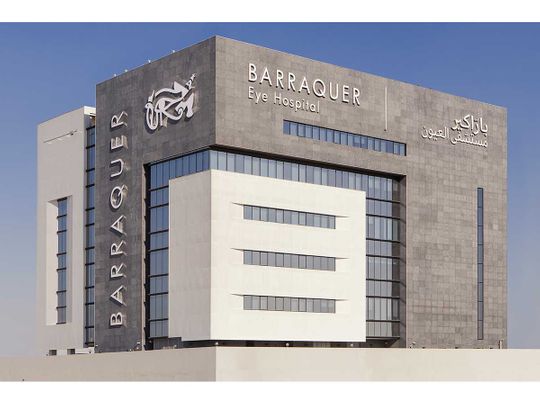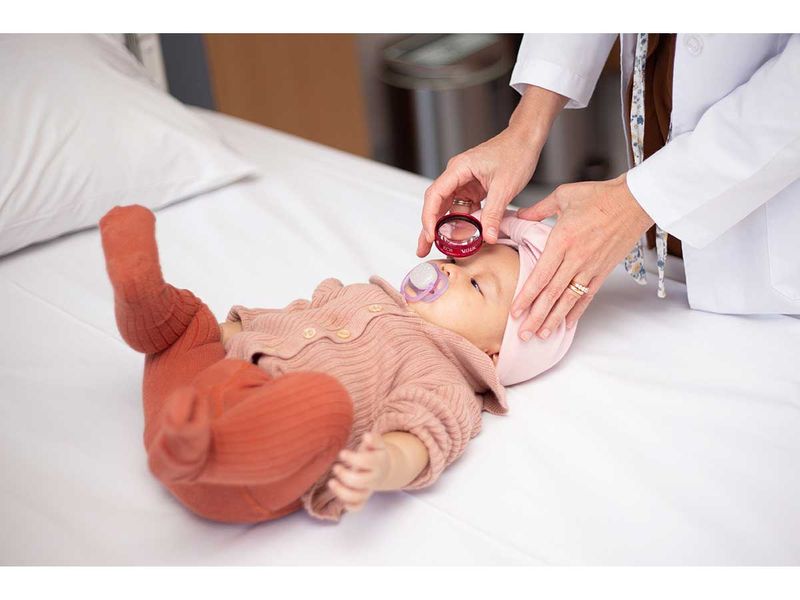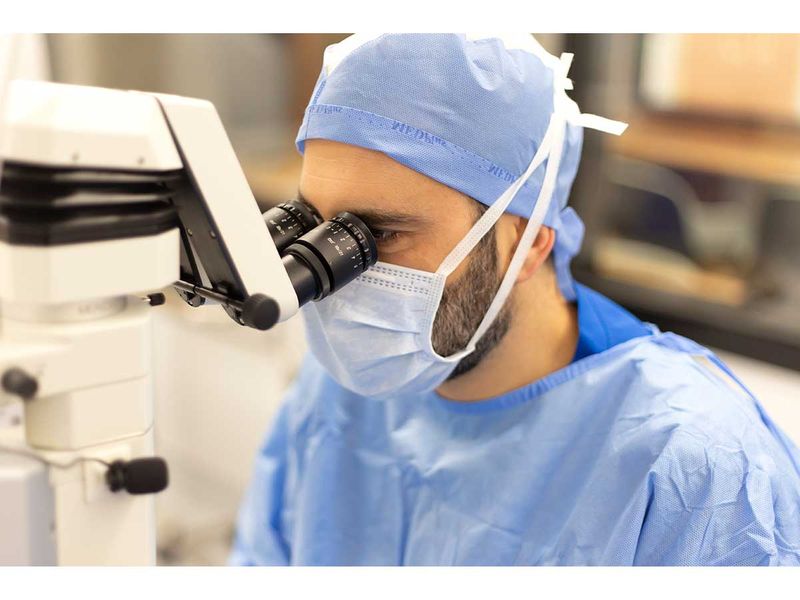
Highlights
Highly experienced ophthalmologists at the leading Spanish opthalmic hospital provide solutions for a wide range of common, chronic and complex eye issues
Barraquer Eye Hospital is a specialised and stand-alone, five storied hospital dedicated to ophthalmic care in Dubai. Barraquer Eye Hospital in the UAE is affiliated to the world-renowned Barraquer Eye Hospital in Barcelona, which boasts over 80 years of legacy in eye care. Barraquer Eye Hospital Spain was founded in 1941 by Dr Jose Barraquer and is now headed by Dr Rafael Barraquer, who is from the fourth generation of the family.
Barraquer Eye Hospital in Dubai is the first branch of the Spanish hospital, and is one of the specialised, dedicated hospitals in eye care with in-patient facilities.
Spread over 13,000 sq mt, Barraquer facility has 16 day care units, 8 in-patient rooms, 4 operation theatres, 98 seater auditorium and can treat over 100 eye-related conditions. The hospital’s state-of-the-art facilities and highly qualified staff make it one of the most prestigious eye hospitals in the region providing quality ophthalmic care.
Barraquer Eye Hospital is equipped with the latest technology, including advanced diagnostic tools and surgical equipment, allowing doctors to offer a wide range of treatments for patients with different eye conditions.
The hospital’s medical team is composed of highly trained and experienced professionals who are specialised in all sub specialities of ophthalmology, such as cornea, cataract, glaucoma, retina, paediatrics, and refractive surgery.

The medical team is led by Dr Muhsen Samaan, Medical Director, who has over 40 years of experience in eye care. In addition to being a practising consultant in the hospital, he is an instructor of resident physicians and a professor for the PhD and master courses. At Barraquer Eye Hospital UAE, Dr Samaan heads a team of highly qualified and experienced ophthalmologists who are dedicated to provide comprehensive care to patients. The medical team at the hospital are all Spanish and have been directly transferred from Barraquer Eye Hospital, Barcelona, to the branch in Dubai.
“At Barraquer Eye Hospital, we focus on the well-being of patients as a priority. We have a team of highly experienced and qualified ophthalmology experts who makes sure that a 360 degree check up is conducted for the vision of the patient and at no point their care is compromised,” says Dr Samaan. “Our eyes are the second most, after the brain, complex parts of our body, hence it requires a team of highly qualified experts to examine it and make sure the vision is always at its most optimum level.”
USPs of Barraquer Eye Hospital
Opening its doors in the UAE in October, 2021, Barraquer Eye Hospital claims to be the only ophthalmic hospital in Dubai with an in-patient facility. “What makes us unique is the kind of cases we treat at the hospital. Since our opening, we have seen simple to some of the most complex cases. We recently conducted a corneal transplant in a two-year old toddler. The case was a complex one as the toddler had a congenital cyst over her corneas, which was blocking 70 per cent of her vision, which naturally affected her general lifestyle and her overall development. Our medical team not only cleared the cyst but also conducted a successful cornea transplant to help restore her vision, which, if left untreated, could have led to a compromised vision for her entire life. A successful surgery was performed under the compassionate hands of our multidisciplinary medical team using the latest and advanced technology,” Dr Samaan explains.
In addition to looking at cases related to children, Barraquer also treats complex cases related to surgeries for adults and senior citizens, such as complex cataract cases, prosthetic eyes surgeries, new treatments for droopy eyes, tear duct surgeries, treatment for age-related macular degeneration, diabetes retinopathy and a lot more.
Certain techniques and methods used by its ophthalmologists are unique as only a few physicians use these due to the complexities it may have and expert precision these techniques require.
“In addition to using new practices, we also invest in new trends that will help patients with their conditions such as gene therapy, which involves the use of viruses to deliver corrective genes to the cells of the eye to treat inherited eye diseases,, minimal invasive glaucoma surgery (MIGS), and many more,” says Dr Samaan

“Being a stand-alone hospital which is solely dedicated to eye care, we make sure that we use advanced technology and new treatment methods which are minimally invasive, have lower recovery period and most importantly, are highly successful. The advantage of having a medical team from Barraquer Eye Hospital Spain is that they have worked closely with thousands of patients over decades with all types of eye conditions and they use their priceless experience to provide treatments here. One of our greatest testimonies is when old patients from years want to travel across the continents to continue their treatment or start another treatment with our doctors here in Dubai. Providing our patients with happy vision and understanding how their vision affects their smile is what makes us different. Working tirelessly and compassionately to help give our patients clear vision so that they can create memories, is what makes us different.”
Barraquer Hospital Dubai is also committed to education and research in the field of ophthalmology. The hospital focuses on conducting medical teaching sessions for ophthalmologists and optometrists, providing them with the opportunity to learn from the clinic’s experts and gain hands-on experience in the latest techniques and technologies within the hospital.
Technology in eye care
Technology plays a critical role in the treatment of eye diseases.

Diagnosis and Treatment With the development of advanced diagnostic tools such as optical coherence tomography (OCT) and digital retinal imaging, eye care professionals are able to detect and diagnose eye conditions much earlier than before. Additionally, technology has enabled the development of new treatments for eye conditions such as laser eye surgery and advanced medications for conditions such as glaucoma.
New treatment options Technology has also led to the development of new treatment options for eye conditions. For example, laser surgery has revolutionised the treatment of conditions like cataracts and refractive errors.
Digital screens
The widespread use of digital screens, such as those on computers, smartphones, and tablets, has led to an increase in eye strain and other vision problems. Eye care professionals are now developing strategies to help reduce the impact of digital screens on eye health.
Wearable technology
The development of wearable technology such as smart glasses and contact lenses has opened new possibilities for monitoring and treating eye conditions. For example, smart contact lenses can be used to monitor glucose levels in people with diabetes, while smart glasses can help people with low vision to see more clearly.
Prevalent eye issues in the UAE
Refractive errors: Refractive errors are the most common eye conditions in Dubai and worldwide. They occur when the shape of the eye does not bend light properly, causing blurry vision. The most common types of refractive errors are myopia (nearsightedness), hyperopia (farsightedness), and astigmatism.
Cataracts: These are a common age-related eye condition in which the lens of the eye becomes cloudy, causing blurry vision, glare, and halos around lights. Cataracts can be treated with surgery to remove the cloudy lens and replace it with an artificial one.
Dry eye syndrome: Dry eye syndrome is a condition in which the eyes do not produce enough tears, or the tears evaporate too quickly, causing dryness, burning, and redness. Dry eye syndrome can be treated with artificial tears, lifestyle changes, and in some cases, prescription medications.
Glaucoma: Glaucoma is a group of eye conditions that damage the optic nerve, leading to vision loss and blindness, if left untreated. Glaucoma is a silent disease in its early stages, which is why regular eye exams are essential for early detection and treatment. We can prevent narrow angle of Glaucoma if it is detected early.
Age-related macular degeneration (AMD): AMD is a common age-related eye condition in which the macula, the central part of the retina responsible for sharp, detailed vision deteriorates, causing vision loss. There is currently no cure for AMD, but treatment can slow its progression and preserve vision.
Diabetic retinopathy: Diabetic retinopathy is a complication of diabetes that affects the blood vessels in the retina, causing vision loss and blindness, if left untreated. Regular eye exams are essential for early detection and treatment of diabetic retinopathy.
Conjunctivitis: Also known as pink eye, Conjunctivitis is an inflammation of the conjunctiva, the thin, transparent membrane that covers the white part of the eye and the inner surface of the eyelids. Conjunctivitis can be caused by viral or bacterial infections, allergies, or irritants, and is usually treated with eye drops or ointments.














